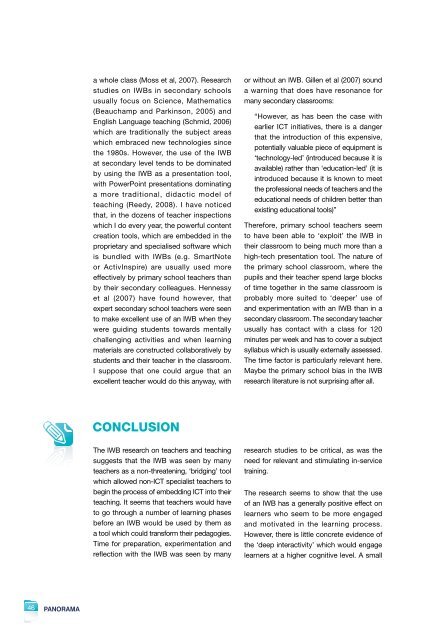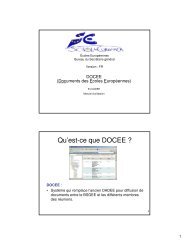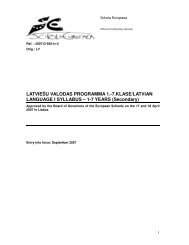Schola Europaea European School Brussels II
Schola Europaea European School Brussels II
Schola Europaea European School Brussels II
You also want an ePaper? Increase the reach of your titles
YUMPU automatically turns print PDFs into web optimized ePapers that Google loves.
46<br />
PANORAMA<br />
a whole class (Moss et al, 2007). Research<br />
studies on IWBs in secondary schools<br />
usually focus on Science, Mathematics<br />
(Beauchamp and Parkinson, 2005) and<br />
English Language teaching (Schmid, 2006)<br />
which are traditionally the subject areas<br />
which embraced new technologies since<br />
the 1980s. However, the use of the IWB<br />
at secondary level tends to be dominated<br />
by using the IWB as a presentation tool,<br />
with PowerPoint presentations dominating<br />
a more traditional, didactic model of<br />
teaching (Reedy, 2008). I have noticed<br />
that, in the dozens of teacher inspections<br />
which I do every year, the powerful content<br />
creation tools, which are embedded in the<br />
proprietary and specialised software which<br />
is bundled with IWBs (e.g. SmartNote<br />
or ActivInspire) are usually used more<br />
effectively by primary school teachers than<br />
by their secondary colleagues. Hennessy<br />
et al (2007) have found however, that<br />
expert secondary school teachers were seen<br />
to make excellent use of an IWB when they<br />
were guiding students towards mentally<br />
challenging activities and when learning<br />
materials are constructed collaboratively by<br />
students and their teacher in the classroom.<br />
I suppose that one could argue that an<br />
excellent teacher would do this anyway, with<br />
CONCLUSION<br />
The IWB research on teachers and teaching<br />
suggests that the IWB was seen by many<br />
teachers as a non-threatening, ‘bridging’ tool<br />
which allowed non-ICT specialist teachers to<br />
begin the process of embedding ICT into their<br />
teaching. It seems that teachers would have<br />
to go through a number of learning phases<br />
before an IWB would be used by them as<br />
a tool which could transform their pedagogies.<br />
Time for preparation, experimentation and<br />
reflection with the IWB was seen by many<br />
or without an IWB. Gillen et al (2007) sound<br />
a warning that does have resonance for<br />
many secondary classrooms:<br />
“However, as has been the case with<br />
earlier ICT initiatives, there is a danger<br />
that the introduction of this expensive,<br />
potentially valuable piece of equipment is<br />
‘technology-led’ (introduced because it is<br />
available) rather than ‘education-led’ (it is<br />
introduced because it is known to meet<br />
the professional needs of teachers and the<br />
educational needs of children better than<br />
existing educational tools)”<br />
Therefore, primary school teachers seem<br />
to have been able to ‘exploit’ the IWB in<br />
their classroom to being much more than a<br />
high-tech presentation tool. The nature of<br />
the primary school classroom, where the<br />
pupils and their teacher spend large blocks<br />
of time together in the same classroom is<br />
probably more suited to ‘deeper’ use of<br />
and experimentation with an IWB than in a<br />
secondary classroom. The secondary teacher<br />
usually has contact with a class for 120<br />
minutes per week and has to cover a subject<br />
syllabus which is usually externally assessed.<br />
The time factor is particularly relevant here.<br />
Maybe the primary school bias in the IWB<br />
research literature is not surprising after all.<br />
research studies to be critical, as was the<br />
need for relevant and stimulating in-service<br />
training.<br />
The research seems to show that the use<br />
of an IWB has a generally positive effect on<br />
learners who seem to be more engaged<br />
and motivated in the learning process.<br />
However, there is little concrete evidence of<br />
the ‘deep interactivity’ which would engage<br />
learners at a higher cognitive level. A small
















